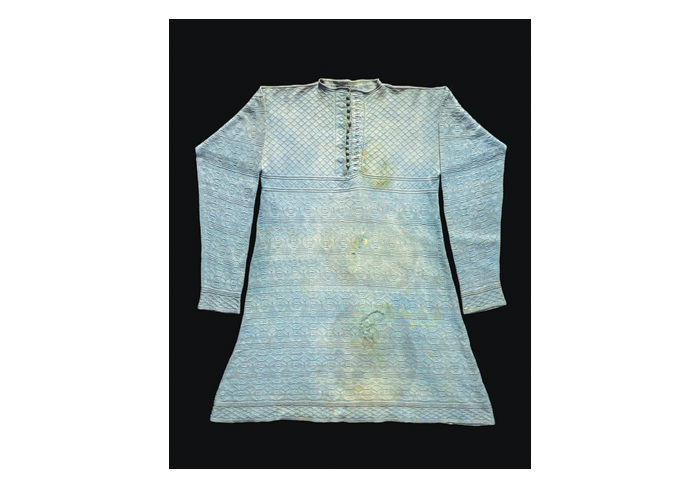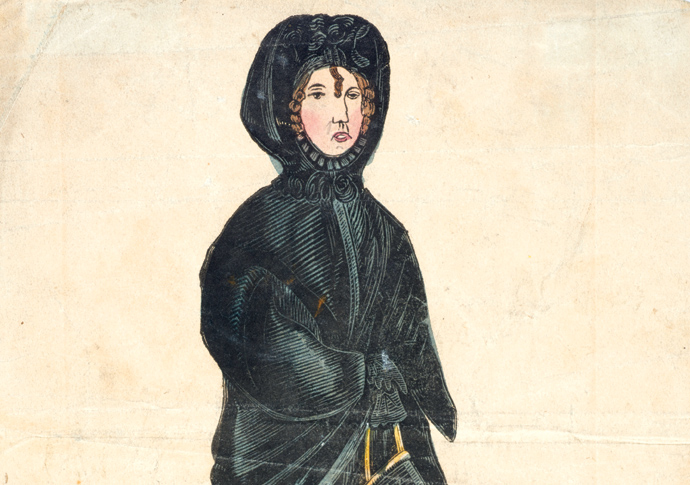Capital’s punishment
Once known as the city of gallows, London was no stranger to executions, as a new exhibition lays bare. Jane Clinton reports
Thursday, 24th November 2022 — By Jane Clinton

Newgate Prison door. This was the first door of three through which prisoners facing public execution passed through on their way to the scaffold outside Newgate. Images: Museum of London
FOR 40 years dressed head-to-toe in black, Sarah Whitehead made a daily journey to the Bank of England. Once there she had just one request: to see her brother Paul.
But every time, Sarah was disappointed. Her brother, once a clerk at the famous bank, had been publicly executed for forgery in 1812.
Sarah, unable to accept his death, became a familiar figure there, acquiring the nickname the “Bank Nun” on account of her funereal garb and veil.
People would take pity and give her scraps of money until bank officials set up a fund to look after her. Her ghost, some suggest, continues to haunt the bank and the environs of Threadneedle Street.
This mournful tale is one of a number of tragic stories sensitively told in the Museum of London Docklands’ latest powerful exhibition: Executions, which charts 700 years of public executions in London. It is the story of the executed, the Londoners who witnessed their deaths, and the impact of public executions on the capital’s landscape, economy and society.
London was known as the city of gallows and the bloodiest of Europe. This was in part because of its massive population, a population that also provided a crowd, seemingly baying for blood.
While Tyburn and Newgate may be familiar to us today as sites of execution, locations were scattered across the capital.

The vest said to have been worn by Charles I at his execution
On a digital display in the exhibition, blood splatters show the numerous execution sites across the capital. And London was certainly soaked in blood. In the City of London, it is said you’re always within 500 metres of a site where gallows once stood.
Records show the first public execution took place at Tyburn in 1196 and the last was in 1868. By this point, Victorian sensibility had decided against such gruesome public spectacles.
And spectacles they were: a form of grisly street entertainment.
Among the methods of execution included being hung, drawn and quartered; beheading; boiling (although this was rarely used) and burning.
The executions attracted a mixed crowd from many different backgrounds including the likes of the writer William Makepeace Thackeray who stated of his experience: “I feel myself ashamed and degraded at the brutal curiosity which took me to that brutal sight.”
By the end of the 18th century, there were more than 200 crimes punishable by death, little wonder so many met their end at the gallows.
These crimes were listed in what was called the “Bloody Code” and veered from the obvious: murder, theft and treason to the bizarre: “Impersonating a pensioner of Greenwich Hospital”.
Another poignant display is the list of more than 5,000 names of people who were executed. One stands out: a boy of just 15 who was executed for burglary.
Public executions and the crowds they attracted spawned a lucrative economy of death with the likes of execution broadsides – one of the earliest examples of mass street literature – sold on the site of the execution. These detailed crimes and trials, with a “good murder” selling up to 250,000 copies. But they were also often guilty of mistakenly describing the executions of reprieved prisoners.
While many of those executed are now forgotten, there were several high-profile executions. Perhaps the most famous being that of Charles I. A knitted silk vest (along with biological stains) he is reputed to have worn during his beheading on a bitterly cold January 30, 1649 in Whitehall, is on display.

Sarah Whitehead, the ‘Bank Nun’
It is said Charles wore two vests during his execution as he didn’t want the crowds to think he was shaking with fear.
On occasion the condemned – whose guilty convictions could be at best described as shaky – successfully petitioned for mercy.
We see examples of these petitions which reveal that, as ever, who you knew could set you free. Being well connected and able to enlist references from prominent members of society had clout and literally opened doors.
There are also last letters by people condemned to death on display for the first time. Some talk of their innocence, or of being strip searched, others of being denied visitors.
These are read by current Pentonville prisoners that brings another layer of poignancy to the words.
For Beverley Cook, curator of Social and Working History at the Museum of London, one of the most affecting items in the exhibition is the enormous door from Newgate Prison.
This was the door the condemned would walk through before they met their end. It is sobering and saddening to stand before it and imagine that final journey.
The end of public executions was brought about by a combination of things including pressure from social reformers as well as the introduction of transportation of convicts to penal colonies like Australia. There was also a shift in sensibility to such public brutality with the Victorian era.
In the UK capital punishment was abolished in 1969 (1973 in Northern Ireland). The death penalty, although unused, remained a legally defined punishment for certain offences such as treason. Capital punishment was completely abolished in the UK in1998.
At present 55 countries retain the death penalty.
Fitting then that the final voice in this exhibition is that of Paul Bridges, the chair of the Amnesty Anti-Death Penalty Project.
• Executions is at the Museum of London Docklands No 1 Warehouse, West India Quay, E14 4AL until 16 April 2023. The recommended age for the exhibition is 12+. See https://www.museumoflondon.org.uk/museum-london-docklands